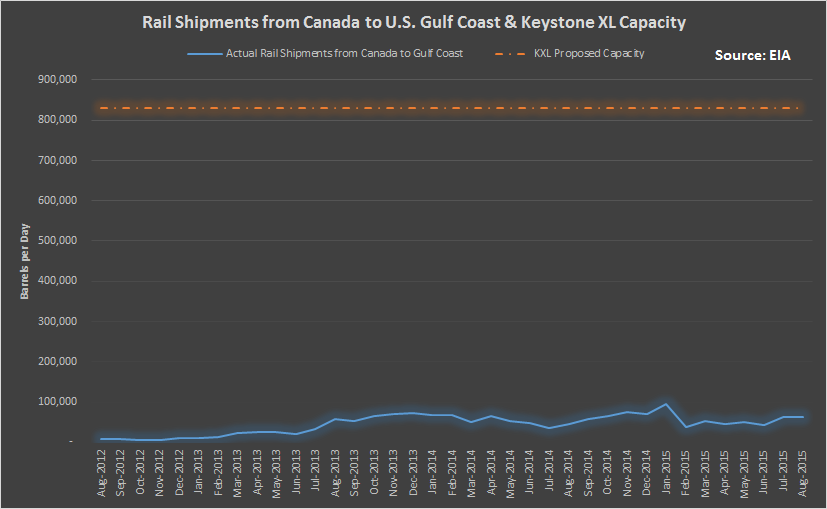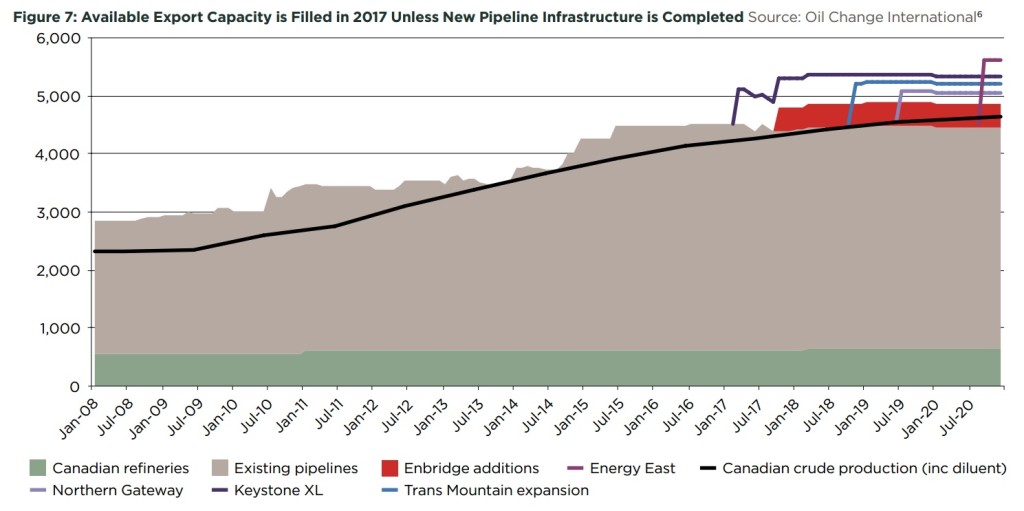The rejection of Keystone XL today marks a turning point for energy decisions: in future, policymakers will be under pressure to consider climate impacts of any new policies and infrastructure.
But it is not only setting a bar for future energy decisions: the climate impact of stopping this pipeline is real. Last week we released analysis finding that the existing pipelines out of Alberta are already 89% full: if no more are built, tar sands production cannot grow.
Just hours after we published, Shell cancelled its 80,000-barrel per day Carmon Creek tar sands project, which was already half-built. The sole reason it gave was “the lack of infrastructure to move Canadian crude oil to global commodity markets”.
Keystone XL was one of five proposed new tar sands pipelines. We now see a real prospect that all of them will be stopped:
- Since the Canadian election result last month, Enbridge’s proposed Northern Gateway – opposed by Justin Trudeau’s Liberal Party – is now generally considered dead.
- Kinder Morgan’s Trans Mountain Expansion, also proposed to the British Columbia coast, faces increasing opposition and legal challenges from First Nations, the public and large municipalities, and extensive criticism of failings of the NEB approval process has led to a running series of delays.
- A set of expansions to the Enbridge Mainline system have recently been delayed following objections from landowners, indigenous groups and local regulators, as public opposition intensifies. The Alberta Clipper expansion, part of that system, is awaiting a State Department decision, and the company’s attempt to circumvent with a routing trick is currently being considered by federal courts following a legal challenge.
- The Energy East pipeline – having already been delayed by two years, this week abandoned its search for a second port terminal, putting the project’s economics on the line, and further reinforcing the Quebec Government’s view that the project offers the province no economic advantage to offset the spill risk; last month, a survey of Montreal residents found 96% against it.
Nor is rail going to take KXL’s place. That’s not just our view: the crude-by-rail industry says it too. According to Stewart Hanlon, President & CEO of Gibson Energy, “Crude by rail is not a panacea. It’s not going to replace pipe.” And in case of any doubt, check out this chart of actual crude-by-rail shipments from Canada over the last three years:

Perhaps unsurprisingly, today some commentators responded to Obama’s announcement with a collective shrug. Citing a recent article in the Wall Street Journal, some pointed out that tar sands are flowing in record volumes into the USA. Those claims miss the point. While new pipelines in Oklahoma and Texas over the last two years have eased past bottlenecks, that has pushed the chokepoint back to the border, where today’s decision hits.
So, ignore the commentators and industry spinners who say this decision doesn’t matter. Today, the climate movement succeeded in keeping a lot of carbon locked safely in the ground.


Maybe there is hope for our species after all.
Thanks for the timely analysis!
Well presented and solid analysis
Thank you for this. I hope you’re right. If they switch to CBR (crude by rail) then a bigger problem has been created. Incidentally, I heard there have been two separate CBR train derailments on the two consecutive days immediately following the KXL decision.
Unci Maka (grandmother earth) needs this big break from fossil fuel emissions
Hi, Greg.
I agree that we must stop CBR too.
We did some recent economic analysis (https://priceofoil.org/2015/10/27/lockdown-the-end-of-growth-in-the-tar-sands/) finding that in fact new tar sands projects would not be viable with rail. The economics are a large part of the reason for the graph above showing how little rail is used for tar sands.
More broadly though, I wouldn’t see it as a choice between pipelines and CBR. Ultimately there isn’t room in the atmosphere for all the carbon contained in the tar sands, so ending the growth of tar sands production is a priority – and that also means no more pipelines and no more rail.
As President Obama said when rejecting Keystone XL, some of the fossil fuel reserves have to stay in the ground, if we are to prevent large parts of the planet becoming unhospitable.